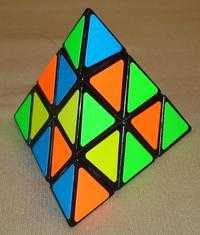Pyraminx

The Pyraminx (/ˈpɪrəmɪŋks/) is a tetrahedral puzzle in the style of Rubik's Cube. It was invented and patented by Uwe Mèffert before the original 3 layered Rubik's Cube by Erno Rubik, and introduced by Tomy Toys of Japan (then the 3rd largest toy company in the world) in 1971.[1]
Description

The Pyraminx was first conceived by Mèffert in 1970. He did nothing with his design until 1981 when he first brought it to Hong Kong for production. Uwe is fond of saying had it not been for Erno Rubik's invention of the cube, his Pyraminx would have never been produced.
The Pyraminx is a puzzle in the shape of a tetrahedron, divided into 4 axial pieces, 6 edge pieces, and 4 trivial tips. It can be twisted along its cuts to permute its pieces. The axial pieces are octahedral in shape, although this is not immediately obvious, and can only rotate around the axis they are attached to. The 6 edge pieces can be freely permuted. The trivial tips are so called because they can be twisted independently of all other pieces, making them trivial to place in solved position. Meffert also produces a similar puzzle called the Tetraminx, which is the same as the Pyraminx except that the trivial tips are removed, turning the puzzle into a truncated tetrahedron.

The purpose of the Pyraminx is to scramble the colors, and then restore them to their original configuration.
The 4 trivial tips can be easily rotated to line up with the axial piece which they are respectively attached to; and the axial pieces are also easily rotated so that their colors line up with each other. This leaves only the 6 edge pieces as a real challenge to the puzzle. They can be solved by repeatedly applying two 4-twist sequences, which are mirror-image versions of each other. These sequences permute 3 edge pieces at a time, and change their orientation differently, so that a combination of both sequences is sufficient to solve the puzzle. However, more efficient solutions (requiring a smaller total number of twists) are generally available (see below).
The twist of any axial piece is independent of the other three, as is the case with the tips. The six edges can be placed in 6!/2 positions and flipped in 25 ways, accounting for parity. Multiplying this by the 38 factor for the axial pieces gives 75,582,720 possible positions. However, setting the trivial tips to the right positions reduces the possibilities to 933,120, which is also the number of possible patterns on the Tetraminx. Setting the axial pieces as well reduces the figure to only 11,520, making this a rather simple puzzle to solve.
Optimal solutions
The maximum number of twists required to solve the Pyraminx is 11. There are 933,120 different positions (disregarding rotation of the trivial tips), a number that is sufficiently small to allow a computer search for optimal solutions. The table below summarizes the result of such a search, stating the number p of positions that require n twists to solve the Pyraminx:
n 0 1 2 3 4 5 6 7 8 9 10 11 p 1 8 48 288 1728 9896 51808 220111 480467 166276 2457 32
Records

The current world record for a single solve of the Pyraminx stands at 1.36 seconds, set by Oscar Roth Andersen of Denmark at the Danish Special 2013.[2] The best average time of 2.56 seconds is held by Drew Brads done at Virginia Open Fall 2014.[3]
Methods
There are many methods for solving a Pyraminx. They can be split up into two groups. The first is layer by layer methods. These aim to solve a face, and then solve the last three edges. There are variations within the methods, but the core idea is the same. Common examples are Bob Burton's method, LBL, and L4E.
The second group is top first methods. These solve all of the centers and three edges around a corner before finishing the last 3 edges. Common top first methods are Keyhole, 1-flip, Oka, WO, and Nutella.
Variations

There are a few variations of the puzzle. The most popular ones are the Professor Pyraminx, which is a higher-order version of the Pyraminx, and the Tetraminx, equivalent to the Pyraminx but without the tips.
See also
- Pyramorphix and Master Pyramorphix, two tetrahedral puzzles which resemble the Pyraminx but are mechanically very different from it
- Rubik's Cube
- Skewb
- Skewb Diamond
- Megaminx
- Dogic
- Combination puzzles
References
- ↑ http://www.mefferts.com/puzzles-pyraminx-kokonotsu.htm
- ↑ World Cube Association: Official results retrieved 12th May 2013.
- ↑
External links
| Wikimedia Commons has media related to Pyraminx. |
- Jaap's Pyraminx and related puzzles page, with solution
- Pyraminx solution from PuzzleSolver
- A solution to the Pyraminx by Jonathan Bowen
- An efficient and easy to follow solution favoured by speed solvers
| ||||||||||||||||||||||||||||||||||||||||||||||||||||||||||||||||||||||||||||||||